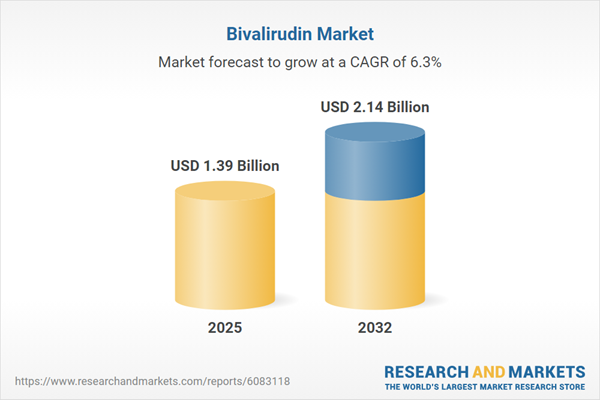Speak directly to the analyst to clarify any post sales queries you may have.
The Bivalirudin market stands at the center of evolving anticoagulation strategies, boosted by its growing adoption across high-acuity care environments globally. Next-generation formulations and resilient supply strategies are reshaping its integration into patient care, driving fresh opportunities and challenges for industry leaders.
Market Snapshot: Strong Growth Trajectory for Bivalirudin
The Bivalirudin market expanded from USD 1.31 billion in 2024 to USD 1.39 billion in 2025, with a projected compound annual growth rate (CAGR) of 6.32% through 2032, ultimately expected to reach USD 2.14 billion. Sustained demand is driven by hospitals, ambulatory surgical centers, and an expanding range of therapeutic applications that prioritize predictable anticoagulation and patient safety alongside workflow efficiency.
Scope & Segmentation: Comprehensive Coverage of Therapeutic and Operational Dimensions
- End User: Hospitals (private, public), Ambulatory Surgical Centers (hospital owned, standalone)
- Formulation Types: Lyophilized powder (for direct use, for reconstitution); Prefilled syringes (glass barrel, plastic barrel)
- Application Areas: Myocardial infarction (NSTEMI, STEMI), Percutaneous coronary intervention (elective PCI, emergency PCI), Unstable angina
- Route of Administration: Intravenous bolus, intravenous infusion (continuous, intermittent)
- Distribution Channels: Hospital pharmacy (in-house, third-party managed), retail pharmacy (chain, independent)
- Regions: Americas (North America, Latin America), Europe, Middle East & Africa (sub-regions), Asia-Pacific (China, India, Japan, and others)
- Companies Analyzed: Fresenius Kabi AG, Pfizer Inc., Teva Pharmaceutical Industries Ltd., Viatris Inc., Apotex Inc., Sandoz International GmbH, Baxter International Inc., B. Braun Melsungen AG
Bivalirudin Market: Key Takeaways for Decision-Makers
- Preference for bivalirudin is increasing among healthcare providers managing complex patient populations with cardiac comorbidities, especially where predictable therapeutic outcomes and rapid anticoagulation are critical.
- Evolving technology has spurred wider adoption of ready-to-use syringes and advanced infusion systems, reducing risk and enhancing operational efficiency in both procedural and emergency care settings.
- Clinical guideline integration and the growth of outpatient procedures have stimulated demand in hospital-owned ambulatory surgical centers, while standalone centers prioritize the drug’s ease of storage and use.
- Segmentation trends reveal divergent inventory and procurement practices between public and private facilities, prompting tailored supply chain and contracting approaches.
- Collaborative partnerships between pharmaceutical and device manufacturers are improving delivery accuracy and supporting optimized patient management pathways.
- Strategic differentiation hinges on investment in digital support tools, localized distribution models, and value-added services for both providers and pharmacists.
Tariff Impact: Navigating 2025 Supply Chain Challenges
Recent United States tariffs on select pharmaceutical ingredients have initiated shifts in bivalirudin’s supply dynamics. Manufacturers have responded by renegotiating contracts, consolidating suppliers, and exploring domestic production to buffer against cost fluctuations. These changes have also prompted tighter collaboration among distributors, regulators, and providers to enhance procurement resilience and maintain clinical supply continuity.
Methodology & Data Sources
The analytical framework combines primary interviews with interventional cardiologists, pharmacists, supply chain managers, and hospital leaders, supported by secondary research from regulatory filings, import/export databases, and peer-reviewed clinical literature. Quantitative insights derive from procedural data, tariff trends, and distribution patterns. Triangulation and segmentation analysis ensure findings reflect real-world conditions and actionable intelligence.
Why This Report Matters
- Enables executive teams to anticipate product demand shifts by mapping new clinical adoption pathways and regulatory variables.
- Equips supply chain leaders and commercial strategists with granular segmentation and regional insights required for confident procurement and partnership decisions.
- Supports tailored operational planning, enhancing readiness to respond to evolving guidelines, technology rollouts, and regional patient demographics.
Conclusion
Bivalirudin is poised for expanded integration across acute and procedural care, supported by innovations in formulation and delivery. Industry participants adopting adaptive sourcing, targeted training, and regionalized strategies will secure a distinct advantage in this dynamic therapeutic market.
Table of Contents
3. Executive Summary
4. Market Overview
7. Cumulative Impact of Artificial Intelligence 2025
Companies Mentioned
The companies profiled in this Bivalirudin market report include:- Fresenius Kabi AG
- Pfizer Inc.
- Teva Pharmaceutical Industries Ltd.
- Viatris Inc.
- Apotex Inc.
- Sandoz International GmbH
- Baxter International Inc.
- B. Braun Melsungen AG
Table Information
| Report Attribute | Details |
|---|---|
| No. of Pages | 185 |
| Published | October 2025 |
| Forecast Period | 2025 - 2032 |
| Estimated Market Value ( USD | $ 1.39 Billion |
| Forecasted Market Value ( USD | $ 2.14 Billion |
| Compound Annual Growth Rate | 6.3% |
| Regions Covered | Global |
| No. of Companies Mentioned | 9 |









